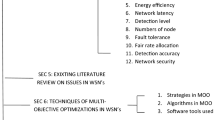Abstract
The foremost challenge in designing Wireless Sensor Networks (WSNs) is careful node placement. Sensor Node placement is a one of the powerful optimization technique for accomplishing the anticipated goals. This paper focuses on categories of node deployment in WSN. The paper highlights various problems and identifies the different objectives in sensor node deployment. The paper proposes a novel node deployment strategy based on Quasi- random method of low-discrepancy sequences to increase the lifetime and the coverage of the network. The aim of the paper is to study how the node deployment affects the different QoS parameters such as packet delivery ratio, average energy consumption, delay, etc. with various multi-objective routing algorithms WSN. To validate the proposal simulation, results are presented in this paper. The paper concludes with the future outlook.








Similar content being viewed by others
References
Bhateja, V., Krishn, A., Patel, H., & Sahu, A. (2015). Medical image fusion in wavelet and ridgelet domains: A comparative evaluation. International Journal of Rough Sets and Data Analysis (IJRSDA), 2(2), 78–91.
Cinque, M., Coronato, A., & Testa, A. (2012). Dependable services for mobile health monitoring systems. International Journal of Ambient Computing and Intelligence (IJACI), 4(1), 1–15.
Kumar, S., & Nagarajan, N. (2013). Integrated network topological control and key management for securing wireless sensor networks. International Journal of Ambient Computing and Intelligence (IJACI), 5(4), 12–24.
Nizar Banu, P. K., & Andrews, S. (2015). Performance analysis of hard and soft clustering approaches for gene expression data. International Journal of Rough Sets and Data Analysis (IJRSDA), 2(1), 58–69.
Pantazis, N., Nikolidakis, S., & Vergados, D. (2013). Energy-efficient routing protocols in wireless sensor networks: A survey. Journal of IEEE Communications Surveys and Tutorials, 15(2), 551–591.
Yessad, S., Bouallouche-Medjkoune, L., & Aïssani, D. (2014). A cross-layer routing protocol for balancing energy consumption in wireless sensor networks. Springer Journal of Wireless Personal Communications, 81(3), 1303–1320.
Sara, G., & Sridharan, D. (2014). Routing in mobile wireless sensor network: A survey. Springer Journal of Telecommunication Systems, 1(57), 51–79.
Kulkarni, N., Prasad, R., Cornean, H., & Gupta, N. (2011). Performance Evaluation of AODV, DSDV & DSR for Quasi Random Deployment of Sensor Nodes in Wireless Sensor Networks. In IEEE International Conference on Devices and Communications (ICDeCom-11), (pp. 1–5).
Xing, X., Xie, D., & Sun, Z. (2015). An approximate optimal coverage set algorithm in wireless sensor networks. In IEEE Seventh International Conference on Advanced Computational Intelligence (ICACI), (pp. 300–305).
Horvat, G., Zagar, D., & Vinko, D. (2014). Influence of node deployment parameters on QoS in large-scale WSN. In IEEE 3rd Mediterranean Conference on Embedded Computing (MECO), (pp. 202–205).
Oliveira, L. M., & Rodrigues, J. J. (2011). Wireless sensor networks: a survey on environmental monitoring. Journal Communication, 6(2), 143–151.
Durisic, M. P., Tafa, Z., Dimic, G., & Milutinovic, V. (2012). A survey of military applications of wireless sensor networks. In IEEE Mediterranean conference on embedded computing (MECO), (pp. 196–199).
Liu, G., Tan, R., Zhou, C. M., González, S., Cao, H., Zhang, Y., et al. (2013). Enabling low bit-rate and reliable video surveillance over practical wireless sensor network. Journal Supercomputing, 65(1), 287–300.
Honghai, Z., & Jennifer, C., H. (2005). Maintaining sensing coverage and connectivity in large sensor networks. In Handbook on Theoretical and Algorithmic Aspects of Sensor, AdHocWireless and Peer-to-Peer Networks, Auerbach Publications.
Ghosh, A., & Das, S. K. (2006). Coverage and connectivity issues in wireless sensor networks. In R. Shorey (Ed.), Mobile, Wireless, and Sensor Networks: Technology, Applications, and Future Directions, John Wiley & Sons, (pp.221–256).
Poe, W. Y., & Schmitt, J. B. (2009). Node Deployment in Large Wireless Sensor Networks: Coverage, Energy Consumption, and Worst-case Delay (pp. 1–8). AINTEC: Proc. ACM.
Abo-Zahhad, M., Sabor, N., Sasaki, S., & Ahmed, S. M. (2016). A centralized immune-Voronoi deployment algorithm for coverage maximization and energy conservation in mobile WSNs. Journal of Information Fusion, Elsevier, 30, 36–51.
Rawat, P., Singh, K. D., Chaouchi, H., & Bonnin, J. M. (2014). Wireless sensor networks: A survey on recent developments and potential synergies. Journal of Supercomputing, 68(1), 1–48.
Kapnadak, V., & Coyle, E. J. (2014). Optimal non-uniform deployment of sensors for distributed detection in wireless sensor networks. ACM Transaction Sensor Network, 10, 1–27.
Sevgia, C., & Koçyiğitb, A. (2014). Optimal deployment in randomly deployed heterogeneous WSNs: A connected coverage approach. Journal of Network and Computer Applications., 46, 182–197.
Sengupta, S., Das, S., Nasir, M. D., & Panigrahi, B. K. (2012). Multi-objective node deployment in WSNs. In search of an optimal trade-off among coverage, lifetime, energy consumption and connectivity. Engineering Applications of Artificial Intelligence, 26, 405–416.
Ramalakshmi, R., & Radhakrishnan, S. (2013). Coverage and connectivity guaranteed deterministic deployment pattern for WSN. Computer Networks & Communications (NetCom), 13, 341–347.
Halder, S., Ghosal, A., Chaudhuri, A., & DasBit, S. (2011). A Probability Density Function for Energy-Balanced Lifetime-Enhancing Node Deployment in WSN. In Proceedings of 11th International Conference on Computational Science and its Application, LNCS, vol. 6018, (pp. 472–487).
Halder, S., Ghosal, A., & DasBit, S. (2011). A pre-determined node deployment strategy to prolong network lifetime in wireless sensor network. Computer Communications, 34(11), 1294–1306.
Marks, M. (2010). A survey of multi-objective deployment in wireless sensor network. Journal of Telecommunication and Information Technology, 3, 36–41.
Lemieux, C. (2009). Quasi- Monte Carlo constructions. In Book Monte Carlo and Quasi-Monte Carlo Sampling, Springer series in Statistics, (pp. 139–197).
Author information
Authors and Affiliations
Corresponding author
Rights and permissions
About this article
Cite this article
Kulkarni, N., Prasad, N.R. & Prasad, R. A Novel Sensor Node Deployment using Low Discrepancy Sequences for WSN. Wireless Pers Commun 100, 241–254 (2018). https://doi.org/10.1007/s11277-017-5063-9
Published:
Issue Date:
DOI: https://doi.org/10.1007/s11277-017-5063-9




